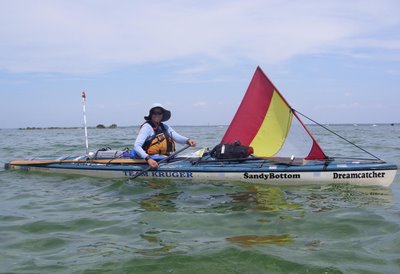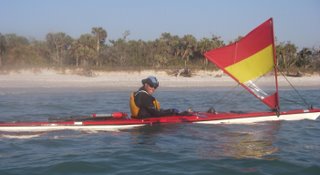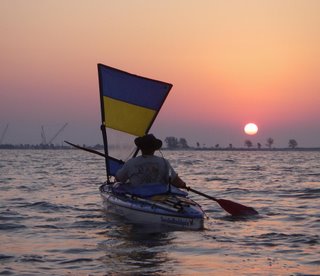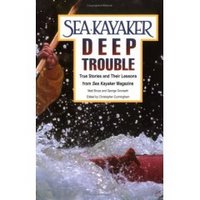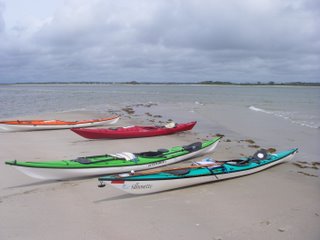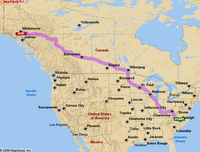I'm always looking for inspiration, and another way. One of the things that originally interested me in
WaterTribe, and that keeps me going back, has to do with it's mission statement. It encourages uniqueness.
"The purpose of WaterTribe is to encourage the development of boats, equipment, skills, and human athletic performance for safe and efficient coastal cruising using minimal impact human and wind powered watercraft based on kayaks, canoes, and small sailboats."
Meeting this purpose, you get a group of real
individuals participating in a Challenge, each in their own way. A
WaterTribe Challenge is an unsupported, expedition style adventure race for kayaks, canoes, and small boats. Challengers paddle or sail a variety of different kinds of boats, all setup somewhat differently, using equipment that may also have had modifications, and arriving at each event having trained in ways that suited themselves. Some of the challengers who live in colder climates have not even been on the water for 3-4 months prior to a Challenge.
I don't know of any other boating event where you can have such a disparate variety of boats, all within the same class. Imagine that Class 1, allowing both kayak or canoe, with or without a small downwind sail, has included boats that vary from a fast 18' long 21" wide fiberglass QCC 700 sea kayak, to a slow 9'8" long 32" wide Stearns inflatable kayak from West Marine, competing against each other. You can really get a feel for the variety of boats and individuals by reading the many articles they have written of past WaterTribe Challenges, published in the WaterTribe Magazine.
other boating event where you can have such a disparate variety of boats, all within the same class. Imagine that Class 1, allowing both kayak or canoe, with or without a small downwind sail, has included boats that vary from a fast 18' long 21" wide fiberglass QCC 700 sea kayak, to a slow 9'8" long 32" wide Stearns inflatable kayak from West Marine, competing against each other. You can really get a feel for the variety of boats and individuals by reading the many articles they have written of past WaterTribe Challenges, published in the WaterTribe Magazine.
Photo at left is of Matt Layden (Wizard) in that inflatable he paddle/sailed in the Michigan WaterTribe 2003 Challenge. See his article "
The Michigan Challenge in a Bubble or What Was He Thinking"
Prior to my finding WaterTribe, if you had asked me about "unique" paddlers who inspire me, I would have told you of two women, also famous for doing it their own way, Audrey Sutherland and Jill Fredston. These are women who are extreme expedition travelers extraordinaire. They have found what works for them, and do not feel bound by the 'typical' way of doing things.
Audrey Sutherland is an inspiration, and an icon of solo wilderness kayaking. Audrey travels the world in an inflatable kayak. Her philosophy is "go simple, go solo, go now". Her choice of an inflatab
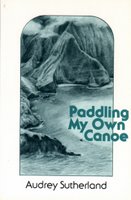
le is certainly considered unconventional in the kayaking world of expedition. She is all about efficiency, light weight, planning, preparedness, and just doing it. She has paddled nearly 7,800 solo miles of British Columbia and Southeast Alaskan coastline. A longtime resident of Hawaii, she started her solo trips paddling the Hawaiian islands, and has also explored South Pacific archipelagos, Norwegian fjords and the
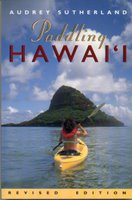
Greek isles, all in an inflatable. I'd read that since she began paddling some 36 years ago, Audrey Sutherland has paddled more that 12,000 solo miles. And, the best of all, she's 81 years old, still paddling.
Audrey has written two books, "Paddling my Own Canoe" and "Paddle Hawaii". Considered a living legend by some, her philosophy and unique style are a rare treat. In an October 2004 Sea Kayaker Magazine interview she was asked:
"I think many paddlers, women especially, regard you as a role model. How do you think you may have inspired others?" She replied "inspiration without nuts and bolts practicality and bit-by-bit efficiency is futile".
Jill Fredston, isn't even a paddler, she is an expedition rower. Her boat is a modified Necky double sea kayak, opened up between the two cockpits where a rowing sliding seat is installed. Jill and her husband Doug Fesler are avalanche experts living in Alaska who, during their summers, take long distance rowing expeditions throughout the northern latitudes of Alaska, Canada, Greenland, Spitsbergen and Norway and Sweden. This for three months of each year. A dream come true.
Jill's book "Rowing to Latitude", is one of my all time favorite expedition books, where alo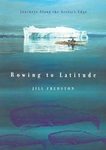 ng with great stories of her and her husbands adventures, she talks about how and why she does it her way, rowing. Read an excellent review of her book, I couldn't begin to do it justice. For those who can't, or who will only ever dream about expedition, this is a book that will let you travel with her. An aside, during the trips described in her book, her husband would paddle along side, I've recently read somewhere that Doug is now also rowing.
ng with great stories of her and her husbands adventures, she talks about how and why she does it her way, rowing. Read an excellent review of her book, I couldn't begin to do it justice. For those who can't, or who will only ever dream about expedition, this is a book that will let you travel with her. An aside, during the trips described in her book, her husband would paddle along side, I've recently read somewhere that Doug is now also rowing.
In one place in her book, she mentions always getting asked 'how can you stand not seeing where you are going", her fantastic reply was something like, "how can you stand not seeing where you've been".
An article on Jill in NationalGeographic.com begins with:
A U.S. Navy adage maintains that it's foolish to travel north of the Arctic Circle clad in anything less than a nuclear submarine. Most people would agree. For rower Jill Fredston, however, ignoring such advice has become an intoxicating way of life.
Jill says her journeys are "neither a vacation nor an escape, they are a way of life".
These two women don't just dream their dreams, they live them, and they live them their own way.
I totally get that.


 are $700 for MS, completing the ride, and loosing 28 lbs. Accountability (and a check on your investment/donation) can be followed on my MS150 training log. I'll update my training, and do a weekly weigh in (I've added a new link on the blog sidebar).
are $700 for MS, completing the ride, and loosing 28 lbs. Accountability (and a check on your investment/donation) can be followed on my MS150 training log. I'll update my training, and do a weekly weigh in (I've added a new link on the blog sidebar). 